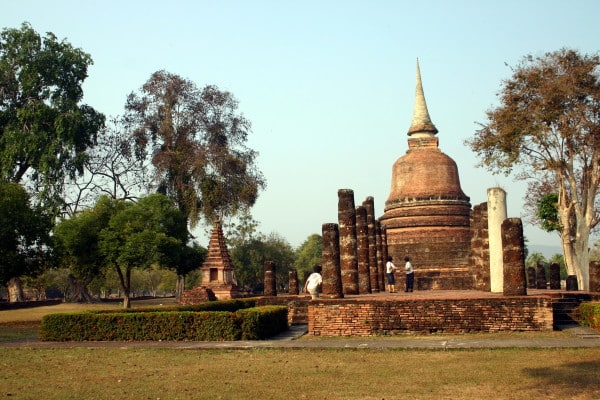Table of Contents
Tucked away in a small alley near the popular backpacker district of Khao San Road, Wat Chana Songkhram is a hidden gem that is worth exploring.
History and Background
The temple is believed to have been built during the reign of King Rama III in the early 19th century. However, the exact year of its construction is unknown.
The temple was originally named Wat Kaeo, which means “Crystal Temple,” due to the crystal Buddha image that was enshrined within its walls. However, the temple was later renamed to Wat Chana Songkhram, which means “Temple of the Victory in the War.”
The reason for the renaming of the temple is due to its historical significance during the Burmese-Siamese War in 1767.
During this time, the Burmese army invaded and occupied the city of Ayutthaya, which was then the capital of Siam (now Thailand). The Siamese army, led by King Taksin, fought back and eventually drove out the Burmese army, thereby reclaiming the city.
After the war, King Taksin established a new capital in Thonburi, which is located on the west bank of the Chao Phraya River. He also commissioned the construction of several temples in the new capital, including Wat Chana Songkhram.
The temple was built as a tribute to the Siamese soldiers who fought and died in the war against the Burmese. The temple’s name, which means “Temple of the Victory in the War,” is a testament to the bravery and heroism of the Siamese soldiers who fought for their country.
Over the years, Wat Chana Songkhram has undergone several renovations and restorations. In 1994, the temple underwent a major renovation project, which saw the restoration of the temple’s ancient murals and the addition of a new bell tower.
Today, Wat Chana Songkhram is considered to be one of the most important temples in Bangkok.
It is a popular destination for both tourists and locals alike, who come to pay their respects to the temple’s revered Buddha images and to experience the temple’s serene and tranquil atmosphere.
Architecture and Design
The temple’s design is a blend of traditional Thai and Chinese architectural styles, with a three-tiered roof and intricate gold and red decorations.
The temple’s main hall, or ubosot, is where monks perform religious ceremonies and where visitors can pay their respects to Buddha. The walls of the ubosot are decorated with beautiful murals depicting the life of Buddha.
The temple’s most impressive feature is its tall and ornate chedi, or stupa, which stands at 25 meters high. The chedi is covered in gold and red tiles and is adorned with intricate carvings and detailed sculptures.
Visitors can climb up to the top of the chedi for a panoramic view of the surrounding area.
Another unique feature of Wat Chana Songkhram is its small library, or ho trai, which is built on stilts above a small pond. The library houses important Buddhist scriptures and texts, and visitors can browse through the books and learn more about Buddhism.
Visiting Wat Chana Songkhram
Wat Chana Songkhram is located in the Banglamphu area of Bangkok, just a short walk from the bustling Khao San Road. The temple is open to visitors every day from 9:00 am to 5:00 pm, and admission is free.
When visiting Wat Chana Songkhram, it’s important to dress respectfully and remove your shoes before entering the temple buildings. Visitors should also be mindful of their behavior and refrain from speaking loudly or engaging in inappropriate behavior.
Exploring the Temple Grounds
Upon entering the temple grounds, visitors will be greeted by a peaceful and serene atmosphere. The temple is surrounded by lush greenery, and the sound of birds chirping can be heard in the distance.
The main hall of the temple, or ubosot, is the first building visitors will see, and it’s an impressive sight. The walls of the ubosot are adorned with intricate murals depicting the life of Buddha, and the smell of incense fills the air.
After paying your respects to Buddha in the ubosot, take a stroll around the temple grounds to explore the other buildings and features. The chedi is a must-see, with its towering height and intricate details.
Visitors can climb up to the top of the chedi for a stunning view of the surrounding area.
The small library, or ho trai, is another unique feature of Wat Chana Songkhram. The library is built on stilts above a small pond, and visitors can browse through the books and learn more about Buddhism. The pond is also home to a few turtles, which can be seen swimming around.
Final Thoughts
Wat Chana Songkhram is a hidden gem in the heart of Bangkok that is often overlooked by visitors. However, the temple’s rich history, stunning architecture, and tranquil atmosphere make it a must-visit destination.
Whether you’re a seasoned traveler or a first-time visitor to Bangkok, Wat Chana Songkhram is a temple that should not be missed. Take the time to explore the temple grounds, pay your respects to Buddha, and soak in the serene atmosphere that can be found in this hidden gem in the heart of Bangkok.



